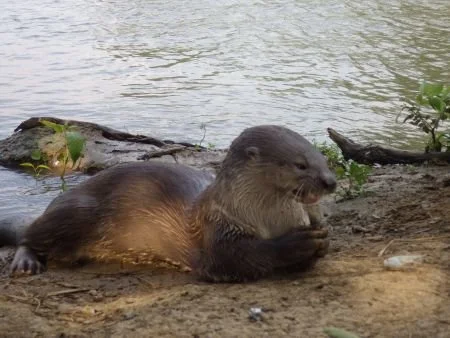Meet Dr Pablo Hernández-Romero
Dr Pablo Hernández-Romero was our co-ordinator out in Mexico and we would love to give you some more information about the man who is helped us make the workshop happen!
Pablo studied biology in Aguascalientes, Mexico. When studying his degree, otters caught his attention, but where he lived there were no otters. So, he decided he had to move to another city to study his Masters and doctorate with a focus on the conservation and evolution of Neotropical otters. Pablo is currently doing a post-doctorate at the National Autonomous University of Mexico and has now worked in more than nine states of the republic on otter conservation issues. A highlight for Pablo has been travelling to international conferences and workshops related to the study of otters.
What made you want to help otters/go into otter conservancy?
I was interested in otters because they fulfil a fundamental ecological role in the aquatic ecosystems of Mexico and because of the lack of researchers who dedicated their studies to the conservation of the species. In addition to this, the trends of their populations in the country showed to be decreasing.
What species of otter is your main focus and why?
The Neotropical otter, Lontra longicaudis, is the species with which I have worked for the past 14 years. I chose this species because it is the otter with the largest range of distribution in Mexico and because it was listed by the IUCN as a Data Deficient species. More information was required to better understand this species and take better measures for its conservation.
What are the biggest threats facing otters in Mexico?
The Neotropical otter faces different threats, such as the destruction and contamination of its habitat, which is one of their main threats. Other issues include overfishing, hunting, death due to fishermen-otter conflict, capture for pets and the misinformation of people due to the importance of the conservation of the species in its natural habitat.
Neotropical otter - Dr Pablo Hernandez-Romero
What is the best part of your job (with otters/wildlife/conservation)?
The best part of working with otters and their conservation is traveling and seeing new places, landscapes and people. It is very gratifying that developing this work has allowed me to help people from the local communities and also the conservation of otter and natural resources at the same time.
And the worst?
That it is not always well paid to carry out conservation projects and the resources to support these projects are restricted.
If you could do one thing for otters, what would it be?
That people know more about them, for their conservation
If you could do one thing for otters, what would it be?
That people know more about them, for their conservation
Neotropical otter - Estuardo Vila
A massive thank you to Pablo for answering our questions, and we look forward to the Mexico Workshop in November!



